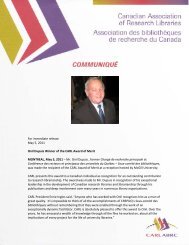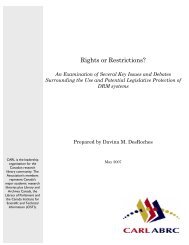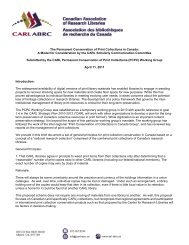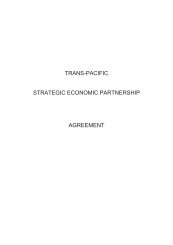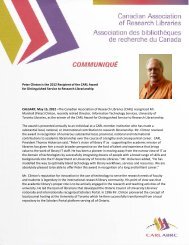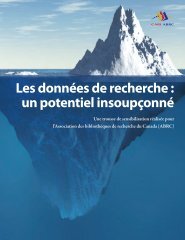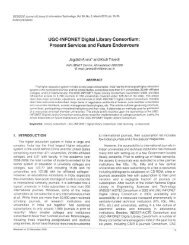PDF - CARL - ABRC
PDF - CARL - ABRC
PDF - CARL - ABRC
Create successful ePaper yourself
Turn your PDF publications into a flip-book with our unique Google optimized e-Paper software.
might happen. There are still many questions about how the digital<br />
and the print compare. Is it an exact match? If it is not an exact match,<br />
how close is close enough?<br />
“It appears that many libraries recognize the<br />
need to reduce print collection footprints,<br />
especially those print collections which<br />
duplicate digital, but have many questions<br />
and hesitancies about how that reduction<br />
might happen.”<br />
The survey of the directors of Ontario university libraries shows<br />
diverse opinions on how to approach print collection archiving. The<br />
value of the print volume as an artifact is a concern. Even if research<br />
articles are exactly duplicated in digital, how important is other<br />
content that is in the print volume but not in the digital version? If<br />
there is one copy of the print journal within easy reach, or within easy<br />
interlibrary loan range, is that sufficient? Can libraries trust digital<br />
resources to deliver reliable content to our patrons over the longterm?<br />
Should we hang on to our print collections that duplicate the<br />
digital just in case?<br />
There seems to be consensus that the answer to these difficult<br />
questions lies in partnerships between institutions. Whether through<br />
already-existing consortial partnerships or by building new collaborations<br />
between institutions, libraries working together to manage print<br />
collections presents a range of options. Yet collaboration itself comes<br />
with risks. A library must have trustworthy partners to maintain print<br />
collections to an agreed-upon level. Choices must be made on whether<br />
to use a distributed or a centralized model. Library administrators<br />
must also determine how much any collaborative effort will cost, how<br />
each partner will pay for its share, and whether one collaborative effort<br />
should duplicate the work being done by another. If there is more than<br />
one consortium in the United States dedicated to maintaining a<br />
specific print collection, does Canada need to duplicate that effort?<br />
The Ontario Council of University Libraries has built an impressive<br />
infrastructure for its digital resources through Scholars Portal. How<br />
can OCUL institutions leverage that infrastructure to help them<br />
evaluate and manage their print collections? As illustrated by the<br />
responses from the OCUL directors, different libraries have different<br />
needs. Some are in urgent need to weed print collections and others<br />
have time to plan for future weeding. A number feel a distributed<br />
network of print collection management would work well, still others<br />
advocate for a centralized facility to ensure a last print copy is retained<br />
in the province. All agree that cost is an over-riding factor and the<br />
unknowns with respect to future budgets make committing to any<br />
long-term plan difficult.<br />
Though this conclusion seems to only pose more questions, and<br />
admittedly many more could be listed, what is clear is that this issue is<br />
of immense interest, and immense importance for the academic<br />
library community. Continuing the conversation is essential as is the<br />
need to ensure we work together across regions, states, provinces,<br />
countries, and even internationally to develop strategies.<br />
NOTES AND REFERENCES<br />
1. Paul Genoni, Current and Future Print Storage for Australian<br />
Academic Libraries: Results of a Survey, Library Collections,<br />
Acquisitions, & Technical Services 32 (2008): 31-41, and, American<br />
University Library, “The Academic Library in 2010: A Vision, Report of<br />
a Symposium 2010, March 14-15, 2005”. Online (November, 2009)<br />
Available: http://www.library.american.edu/Symposium_2010.<br />
pdf.<br />
248 The Journal of Academic Librarianship<br />
2. Lizanne Payne, Library Storage Facilities and the Future of Print<br />
Collections in North America. OCLC (2007) Available: www.oclc.<br />
org/programs/publications/reports/2007-01.pdf (October 1,<br />
2009).<br />
3. Cathy Maskell, “Last Copy and Low Use Print Repositories: A Vision<br />
and First Steps for OCUL” (report submitted to OCUL Directors<br />
Meeting, September 2008).<br />
4. Lizanne Payne, Are Duplicate Copies the Double Edged Sword for<br />
Last Copy Repositories?: Perspective on Consortium Repository.<br />
(Slide presentation as transcribed by Jean Ann Croft, and Atalanta<br />
Grant-Suttie, Preservation issues in small to mid-sized libraries<br />
discussion group in email to PADG mailing list). Online (July 2005)<br />
Available: http://palimpsest.stanford.edu/byform/mailing-lists/<br />
padg/2005/07/doc00000.doc (April 28, 2009).<br />
5. RLG and OCLC, Trusted Digital Repositories: Attributes and<br />
Responsibilities: An RLG-OCLC Report. RLG & OCLC (2002)<br />
Available: http://www.oclc.org/research/activities/past/rlg/<br />
trustedrep/repositories.pdf (October 1, 2009).<br />
6. Brian E.C. Schottlaender, “You say you want an evolution…’ The<br />
Emerging UC Libraries Shared Collection,” Library Collections,<br />
Acquisitions, & Technical Services 28 (2004): 13–24.<br />
7. Brian E.C. Schottlaender, Gary S. Lawrence, Cecily Johns, Claire Le<br />
Donne, and Laura Fosbender, Collection Management Strategies in<br />
a Digital Environment: A Project of the Collection Management<br />
Initiative of the University of California Libraries. Online. University<br />
of California, Office of the President, Office of Systemwide<br />
Library Planning. (2004) Available: http://www.ucop.edu/cmi/<br />
finalreport/cmireportfinal.pdf, viii. (April 28, 2009).<br />
8. Jim Agee and Sarah Naper, “Off-site storage: An analysis,”<br />
Collection Building 26 (2007): 20-5, 21.<br />
9. Carol Hansen Montgomery, “‘Fast Track' Transition to an Electronic<br />
Journal Collection: A Case Study,” New Library World 101 (2000):<br />
294-302, 295-296.<br />
10. Steve O'Connor, Andrew Wells, and Mel Collier, “A Study of<br />
Collaborative Storage of Library Resources,” Library Hi Tech Journal<br />
20 (2002): 258–269.<br />
11. Steve O'Connor and Cathie Jilovsky, “Approaches to the storage of<br />
low use and last copy research materials,” Library Collections,<br />
Acquisitions, & Technical Services 32 (2009): 121–126.<br />
12. Payne, “Library Storage Facilities.”<br />
13. Geoffrey Su, Print Repository Initiatives at Canadian University<br />
Libraries: An Overview. Online. <strong>CARL</strong> <strong>ABRC</strong> (2006) Available:<br />
http://www.carl-abrc.ca/projects/preservation/pdf/print_repos_<br />
overview.pdf (April 28, 2009).<br />
14. The institutions described in the report were the University of<br />
British Columbia, Carleton University, the University of Manitoba,<br />
the University of Ottawa, the Quebec universities, the University of<br />
Saskatchewan, the University of Toronto, and the University of<br />
Western Ontario. The shared initiatives described in the report<br />
were the BARD project in Alberta, the Council of Atlantic University<br />
Libraries (CAUL) Regional Consortium for the Preservation of<br />
Scholarly Materials, the (OCUL) Collaborative Collection Continuity<br />
Initiative, and the TriUniversity Group (TUG) Libraries Annex.<br />
15. Su, “Print repository initiatives,” p. 27.<br />
16. Tri-University Group of Libraries. Policies - TUG Libraries Last<br />
Copy. Online. Guelph University Library. (2006) Available: http://<br />
www.lib.uoguelph.ca/about/policies/TUG_libraries_last_copy.<br />
cfm (April 29, 2009).<br />
17. Su, “Print repository initiatives,” p. 29.<br />
18. O'Connor, Wells, and Collier, “A Study of Collaborative Storage of<br />
Library Resources.”<br />
19. Payne, “Are Duplicate Copies the Double Edged Sword.”<br />
20. Charlotte Marie Knoche, “Critical Factors for Successful Collaboration<br />
in Academic Libraries,” PhD diss.,” University of Minnesota,<br />
1997.



